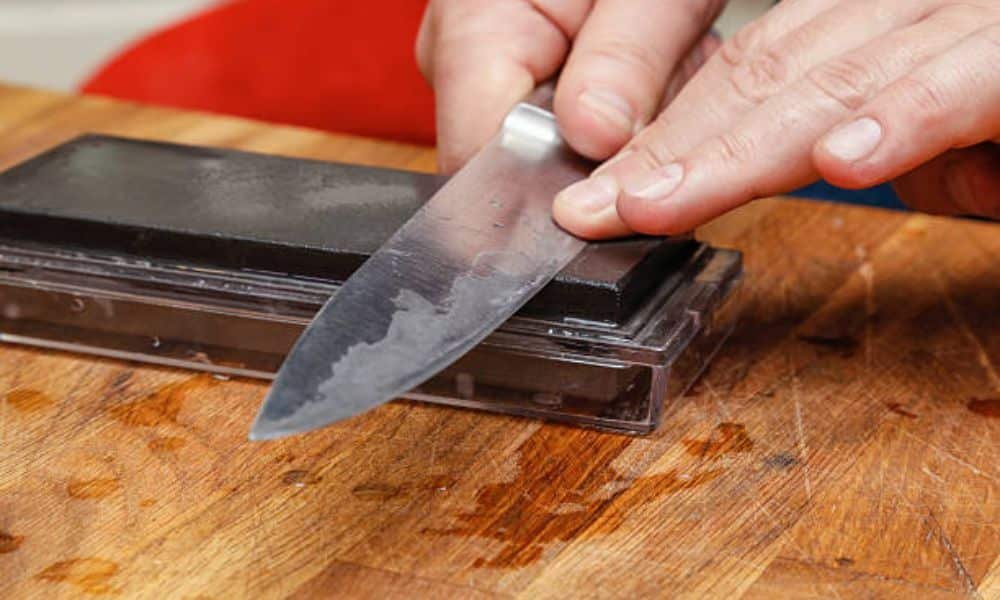I once tried to chop an onion with a dull knife. It was a rainy Sunday, and I wanted to make my grandmother’s lentil stew. My knife crushed the onion, slipped, and nearly cut my finger. That moment taught me something big: dull blades are dangerous. Now, I sharpen my knives often. It’s become part of my kitchen rhythm. Like brewing coffee or wiping down the counters. A sharp knife means safety, ease, and joy. In this post, I’ll show you how to use a kitchen knife sharpener. It’s easy to learn, and it changes everything.
Why Knife Sharpening Matters
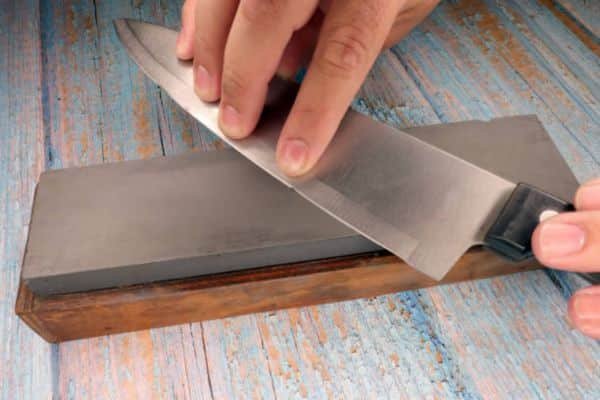
Let’s talk about why this matters. Have you struggled to slice a tomato? Or had to push hard to cut a carrot? That’s a clear sign is dull.
A sharp knife makes kitchen prep fast and easy. It lowers the risk of slipping and cutting yourself. It also gives cleaner cuts, which helps food cook better and look nicer.
You don’t need anything fancy to fix it. A simple sharpener at home can do the job well. You just need to know the right way to use it. And if you’re starting from scratch, check out the Best Kitchen Knife Set Under 100 — it’s budget-friendly and perfect for everyday use.
What Kind of Sharpener Are We Talking About?
There are three main types of knife sharpeners you can use at home.
Manual pull-through sharpeners are simple and safe. Most have two or three slots. You pull the knife through to sharpen it. This type is great for beginners.
Electric sharpeners do the same job, but faster. They use a motor to grind the blade. These work well, but some can be too strong.
Sharpening rods, also called honing steels, don’t sharpen. They keep your edge straight between sharpening sessions.
How to Use a Kitchen Knife Sharpener (Step by Step)
01. Set Up Your Station
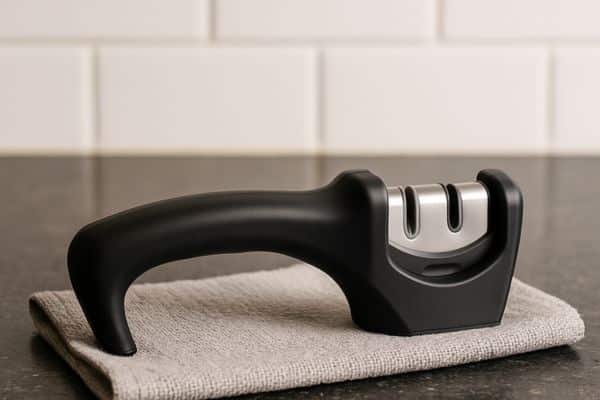
Choose a flat, stable surface with good lighting. Your kitchen counter works great. Place a damp towel under your sharpener to keep it from sliding around. Safety first.
02. Understand the Slots
Most manual sharpeners have two or three slots:
- Coarse Slot (often marked as “Sharpen” or “Carbide”): This one grinds the blade and is used for very dull knives.
- Fine Slot (usually marked as “Hone” or “Ceramic”): This one refines and polishes the edge.
- Some sharpeners have a third medium slot — that’s for in-between sharpening.
Read the labels on your sharpener. If it’s not labelled, check the manual or look up the model online.
03. Start with the Coarse Slot (Only If Needed)
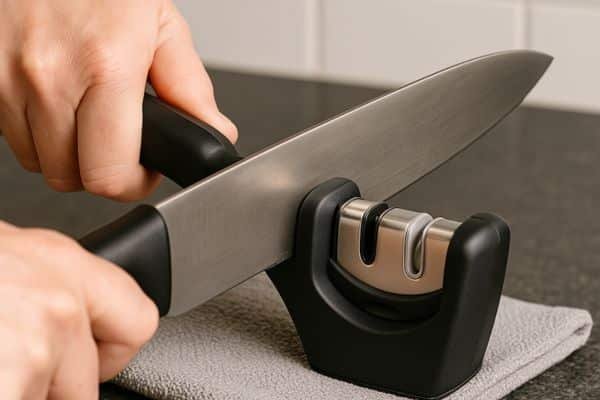
If your knife can’t cut through a ripe tomato or paper easily, it’s dull enough for the coarse slot.
- Hold the handle of the sharpener with one hand.
- Place the heel of the knife (the part closest to the handle) into the slot.
- Apply gentle downward pressure (not too much — let the sharpener do the work).
- Pull the blade through the slot, from heel to tip, in one smooth motion.
- Repeat 3–5 times. More than that can grind away too much metal.
Don’t saw back and forth — always pull in one direction.
04. Move to the Fine Slot
Now it’s time to refine that edge.
- Place the knife in the fine slot.
- Pull it through 3–5 times, same motion — heel to tip, gentle pressure.
- Wipe the blade clean with a damp towel to remove any metal shavings.
05. Test the Edge
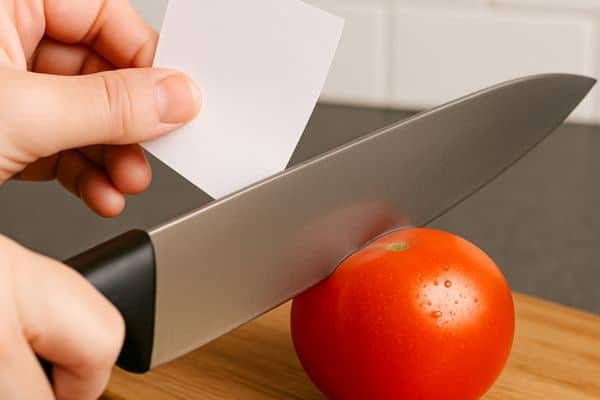
Carefully slice through a piece of paper or a tomato. If the knife glides cleanly, you’ve nailed it. If not, run it through the fine slot again 2–3 more times.
I don’t recommend testing by running your finger along the blade. Trust me — you only need to make that mistake once.
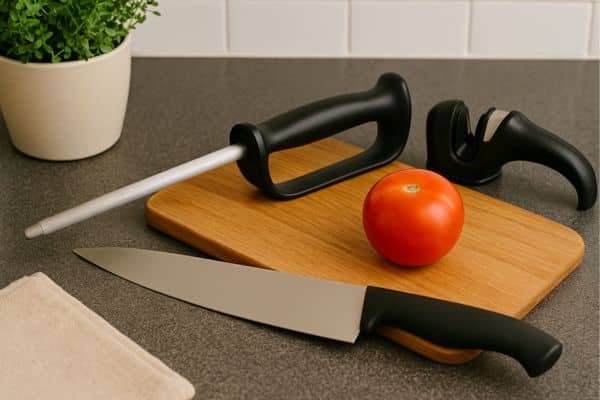
Real-Life Tips from My Kitchen
These are the little things I’ve picked up over the years of sharpening, messing up, and learning again.
Don’t Overdo It
When I first got a sharpener, I was obsessed. I’d sharpen my knife every time I cooked. Bad idea. Sharpening removes a small layer of metal — too much can shorten life. I now sharpen every 1–2 months, depending on use, and hone weekly with a steel.
Clean After Sharpening
Always wipe your knife clean after sharpening. Even a few metal particles left on the blade can end up in your food. I also clean the sharpener every few uses — a quick brush and rinse keeps it working smoothly.
Use the Right Knife
Not all knives should go through a sharpener. Serrated blades (like bread knives) and some Japanese-style knives (with a single bevel) can be damaged by standard sharpeners. Check type before you begin.
Maintain the Angle
Good sharpeners come with preset angles — usually 20 degrees. That’s perfect for most Western knives. Just make sure you’re holding upright as you pull it through, so you’re not shifting that angle.
Respect the Tool
A sharp knife can make you feel like a kitchen ninja, but it also demands respect. Always store your knives safely (a knife block, magnetic strip, or sheath). And never leave them soaking in the sink — that’s how accidents (and rust) happen.
Make It a Habit, Not a Chore
Sharpening your knife might feel like one more task on a busy day. But I see it as a small act of care. Like watering herbs or wiping the counter after dinner. It takes just a minute. And it makes a big difference.
Prep feels smoother. Cutting feels safer. You’ll enjoy your time in the kitchen more.
So the next time your knife mashes a tomato or crushes your garlic, don’t get annoyed. Just sharpen it. It’s a simple gift to your future self.
Final Thoughts
Sharpening a knife for the first time? Go easy. Take your time. Read the instructions that came with your sharpener. A quick video can also help.
But most of all, believe in yourself. If you can follow a recipe, you can do this. Once you sharpen a knife, you’ll see the difference right away. Cooking feels better. Chopping gets easier.
A sharp knife does more than slice food. It saves your hands. It saves time. And it makes your kitchen feel more like your own.
Faqs
What is the best type of kitchen knife sharpener for beginners?
A manual pull-through sharpener is best for beginners. It’s easy to use, safe, and helps keep your knives sharp without much effort.
How often should I sharpen my kitchen knives?
Sharpen your kitchen knives every 1–2 months for best results. For regular care, use a honing rod once a week to keep the edge smooth.
Can a dull knife be more dangerous than a sharp one?
Yes, dull knives are more dangerous. They slip easily and make you press harder, which raises the risk of cutting your fingers while chopping.

